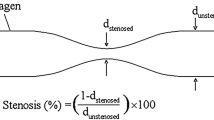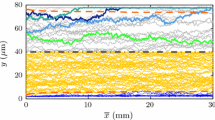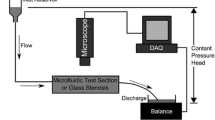Abstract
Thrombosis on an atherosclerotic lesion can cause heart attack or stroke. Thrombosis may be triggered by plaque rupture or erosion, creating a thrombogenic stenosis. To measure and model this situation, collagen-coated stenoses have been exposed to nonanticoagulated blood in a baboon ex vivo shunt. The maximum rate of platelet accumulation, measured using a gamma camera, was highest in the throat region of moderate and severe stenoses, and increased with increasing stenosis severity. A species transport model of platelet accumulation was developed, which included mechanisms of convection, shear-enhanced diffusion, near-wall platelet concentration, and a kinetic model of platelet activation and aggregation. The model accurately reproduced the average spatial pattern and time rate of platelet accumulation in the upstream and throat regions of the stenosis, where shear-enhanced diffusivity increased platelet transport in the stenosis throat. Downstream of the throat where flow is complicated by recirculation, the model computed a transport-limited region with lower than measured platelet accumulation, suggesting that fluid-phase platelet activation may significantly affect both transport and adhesion rates in the poststenotic region. This model may provide an initial quantitative estimate of the likelihood of occlusive thrombus in individual patients due to plaque erosion, artery spasm, incomplete angioplasty, or plaque rupture. © 2001 Biomedical Engineering Society.
PAC01: 8717Aa, 8719Tt, 8719Xx
Similar content being viewed by others
References
Aarts, P. A., S. A. van den Broek, G. W. Prins, G. D. Kuiken, J. J. Sixma, and R. M. Heethaar. Blood platelets are concentrated near the wall and red blood cells, in the center in flowing blood. Arteriosclerosis (Dallas)8:819–824, 1988.
Arbustini, E., B. Dal Bello, P. Morbini, A. P. Burke, M. Bocciarelli, G. Specchia, and R. Virmani. Plaque erosion is a major substrate for coronary thrombosis in acute myocardial infarction. Heart82:269–272, 1999.
Badimon, L., and J. J. Badimon. Mechanisms of arterial thrombosis in nonparallel streamlines: platelet thrombi grow on the apex of stenotic severely injured vessel wall. Experimental study in the pig model. J. Clin. Invest.84:1134–1144, 1989.
Basmadjian, D.The effect of flow and mass transport in thrombogenesis. Ann. Biomed. Eng.18:685–709, 1990.
Bluestein, D., C. Gutierrez, M. Londono, and R. T. Schoephoerster. Vortex shedding in steady flow through a model of an arterial stenosis and its relevance to mural platelet deposition. Ann. Biomed. Eng.27:763–773, 1999.
Bluestein, D., L. Niu, R. T. Schoephoerster, and M. K. Dewanjee. Fluid mechanics of arterial stenosis: relationship to the development of mural thrombus. Ann. Biomed. Eng.25:344–356, 1997.
Boreda, R., R. S. Fatemi, and S. E. Rittgers. Potential for platelet stimulation in critically stenosed carotid and coronary arteries. J. Vasc. Invest.1:26–37, 1995.
Cao, J., and S. E. Rittgers. Particle motion within in vitro models of stenosed internal carotid and left anterior descending coronary arteries. Ann. Biomed. Eng.26:190–199, 1998.
Chaitman, B. R., L. D. Fisher, M. B. Bourassa, K. Davis, W. J. Rogers, C. Maynard, D. H. Tyras, R. L. Berger, M. P. Judkins, I. Ringqvist, M. B. Mock, and T. Killip. Effect of coronary bypass surgery on survival patterns in subsets of patients with left main coronary artery disease. Report of the collaborative Study in Coronary Artery Surgery (CASS). Am. J. Cardiol.48:765–777, 1981.
Constantinides, P.Cause of thrombosis in human atherosclerotic arteries. Am. J. Cardiol.66:37G-40G, 1990.
Davies, M. J.A macro and micro view of coronary vascular insult in ischemic heart disease. Circulation82:II38-II46, 1990.
Davies, M. J., and A. C. Thomas. Thrombosis and acute coronary artery lesions in sudden cardiac ischemic death. N. Engl. J. Med.310:1137–1140, 1984.
Eckstein, E. C., and F. Belgacem. Model of platelet transport in flowing blood with drift and diffusion terms. Biophys. J.60:53–69, 1991.
Elwood, P. C., S. Renaud, D. S. Sharp, A. D. Beswick, J. R. O'Brien, and J. W. Yarnell. Ischemic heart disease and platelet aggregation. The Caerphilly Collaborative Heart Disease Study. Circulation83:38–44, 1991.
European Carotid Surgery Trialists' Collaborative Group.MRC European Carotid Surgery Trial: Interim results for symptomatic patients with severe (70–99%) or with mild (0–29%) carotid stenosis. Lancet337:1235–1243, 1991.
Executive Committee for the Asymptomatic Carotid Atherosclerosis Study.Endarterectomy for asymptomatic carotid artery stenosis. J. Am. Med. Assoc.273:1421–1428, 1995.
Feichter, J. Numerical study of platelet transport in flowing blood. MS. thesis. Georgia Institute of Technology, Atlanta, 1998, 76 pp.
Folie, B. J., and L. V. McIntire. Mathematical analysis of mural thrombogenesis. Concentration profiles of platelet-activating agents and effects of viscous shear flow. Biophys. J.58:1121–1141, 1989.
Folts, J. D., E. B. Crowell, Jr., and G. G. Rowe. Platelet aggregation in partially obstructed vessels and its elimination with aspirin. Circulation54:365–370, 1976.
Hand, N. M., D. Blythe, and P. Jackson. Antigen unmasking using microwave heating on formalin fixed tissue embedded in methyl methacrylate. J. Cell. Pathol.1:31–37, 1996.
Hanson, S. R., H. F. Kotze, B. Savage, and L. A. Harker. Platelet interactions with Dacron vascular grafts. A model of acute thrombosis in baboons. Arteriosclerosis (Dallas)5:595–603, 1985.
Huang, P. Y., and J. D. Hellums. Aggregation and disaggregation kinetics of human blood platelets: Part II. Shear-induced platelet aggregation. Biophys. J.65:344–353, 1993.
Lam, J. Y., J. G. Latour, J. Lesperance, and D. Waters. Platelet aggregation, coronary artery disease progression and future coronary events. Am. J. Cardiol.73:333–338, 1994.
Markou, C. P., S. R. Hanson, J. M. Siegel, and D. N. Ku. The role of high wall shear rate on thrombus formation in stenoses. Advances in Bioengineering, New Orleans, LA: ASME, 1993, pp. 555–558.
North American Symptomatic Carotid Endarterectomy Trial Collaborators.Beneficial effect of carotid endarterectomy in symptomatic patients with high-grade carotid stenosis. N. Engl. J. Med.325:445–453, 1991.
Sakariassen, K. S., R. Muggli, and H. R. Baumgartner. Measurements of platelet interaction with components of the vessel wall in flowing blood. Methods Enzymol.169:37–70, 1989.
Savage, B., P. R. McFadden, S. R. Hanson, and L. A. Harker. The relation of platelet density to platelet age: survival of low-and high-density 111Indium-labeled platelets in baboons. Blood68:386–393, 1986.
Siegel, J. M., C. P. Markou, D. N. Ku, and S. R. Hanson. A scaling law for wall shear rate through an arterial stenosis. J. Biomech. Eng.116:446–451, 1994.
Sorensen, E. N., G. W. Burgreen, W. R. Wagner, and J. F. Antaki. Computational simulation of platelet deposition and activation: I. Model development and properties. Ann. Biomed. Eng.27:436–448, 1999.
Sorensen, E. N., G. W. Burgreen, W. R. Wagner, and J. F. Antaki. Computational simulation of platelet deposition and activation: II. Results for Poiseuille flow over collagen. Ann. Biomed. Eng.27:449–458, 1999.
Strony, J., A. Beaudoin, D. Brands, and B. Adelman. Analysis of shear stress and hemodynamic factors in a model of coronary artery stenosis and thrombosis. Am. J. Physiol.265:H1787–1796, 1993.
Sukavaneshvar, S., G. M. Rosa, and K. A. Solen. Enhancement of stent-induced thromboembolism by residual stenoses: contribution of hemodynamics [see comments]. Ann. Biomed. Eng.28:182–193, 2000.
Sundell, I. B., U. M. Marzec, A. B. Kelly, N. A. Chronos, L. C. Petersen, S. R. Hanson, U. Hedner, and L. A. Harker. Reduction in stent and vascular graft thrombosis and enhancement of thrombolysis by recombinant Lys-plasminogen in nonhuman primates. Circulation96:941–948, 1997.
Thaulow, E., J. Erikssen, L. Sandvik, H. Stormorken, and P. F. Cohn. Blood platelet count and function are related to total and cardiovascular death in apparently healthy men. Circulation84:613–617, 1991.
Torvik, A., A. Svindland, and C. F. Lindboe. Pathogenesis of carotid thrombosis. Stroke20:1477–1483, 1989.
Trip, M. D., V. M. Cats, F. J. van Capelle, and J. Vreeken. Platelet hyperreactivity and prognosis in survivors of myocardial infarction. N. Engl. J. Med.322:1549–1554, 1990.
Turitto, V. T., and H. R. Baumgartner. Platelet deposition on subendothelium exposed to flowing blood: mathematical analysis of physical parameters. Trans. Am. Soc. Artif. Intern. Organs21:593–601, 1975.
Turitto, V. T., H. J. Weiss, and H. R. Baumgartner. The effect of shear rate on platelet interaction with subendothelium exposed to citrated human blood. Microvasc. Res.19:352–365, 1980.
Vaishnav, R. N., D. J. Patel, H. B. Atabek, M. D. Deshpande, F. Plowman, and J. Vossoughi. Determination of the local erosion stress of the canine endothelium using a jet impingement method. J. Biomech. Eng.105:77–83, 1983.
Wagner, W. R., and J. A. Hubbell. Local thrombin synthesis and fibrin formation in an in vitro thrombosis model result in platelet recruitment and thrombus stabilization on collagen in heparinized blood. J. Lab. Clin. Med.116:636–650, 1990.
Wootton, D. M. Mechanistic modeling of occlusive arterial thrombosis. PhD thesis. Georgia Institute of Technology, Atlanta, 1998, 421 pp
Young, D. F., and F. Y. Tsai. Flow characteristics in models of arterial stenoses. II. Unsteady flow. J. Biomech.6:547–559, 1973.
Zydney, A.and C. Colton. Augmented solute transport in the shear flow of a concentrated suspension. PhysicoChemical Hydrodynamics10:79–96, 1988.
Author information
Authors and Affiliations
Rights and permissions
About this article
Cite this article
Wootton, D.M., Markou, C.P., Hanson, S.R. et al. A Mechanistic Model of Acute Platelet Accumulation in Thrombogenic Stenoses. Annals of Biomedical Engineering 29, 321–329 (2001). https://doi.org/10.1114/1.1359449
Issue Date:
DOI: https://doi.org/10.1114/1.1359449




